नैनोटेक्नोलॉजी: कृषि फसलों में फसल सुधार का एक आधुनिक दृष्टिकोण
More than two thirds of the Indian population depends on agriculture for their livelihood, which has probably an impact on the Indian economy. But the Indian agricultural system was not as robust as it is now, either before or after independence.
Green Revolution, which employed some contemporary farming techniques, was the main success story of Indian agriculture. Before the Green Revolution, the country frequently experienced hunger and severe food shortages, and now we find ourselves confronted with the issue of overabundance.
Since the atmosphere in India varies throughout the year, a wide variety of crops are grown there, with rice and wheat serving as the country's two main food staples.
Additionally, grains, pulses, tubers, sugarcane, oilseeds, cotton, tea, coffee, rubber, and jute are grown by Indian farmers. But it was noted that a variety of biological and abiotic stressors, water availability, and expanding world populations all pose threats to the presentations of these crops.
The pressure on crop plants to produce new diseases and pests that reduce crop output has increased as a result of the daily changes in the environment.
Additionally, the amount of land used for agriculture has been steadily declining as a result of the significant rise in global population; therefore, crop yield needs to be raised right now.
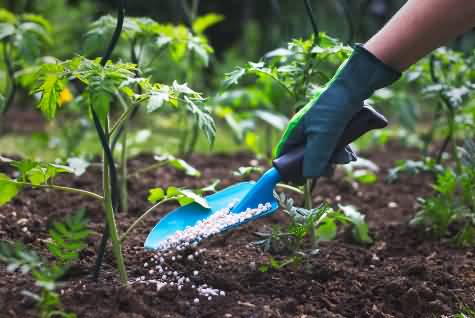 Nanotechnology for Agricultural crops.
Nanotechnology for Agricultural crops.
In order to meet the increased food demand of a fast expanding global population, sustainable agriculture is a critical strategy.
The use of effective pesticides and herbicides, the manipulation of soil features, wastewater management, and disease detection are some of the prospective applications of nanotechnology that could increase agricultural output.
Sustainable agriculture can benefit from nano-biotechnology. Some nanoparticles (NPs) with particular physiochemical properties, however, improve plant growth and stress tolerance by nature rather than serving as nanocarriers.
The physiochemical characteristics of nanoparticles, the application method (foliar distribution, hydroponics, soil), and the concentration used all affect their biological role (Zhao et al., 2020).
This technology is rapidly evolving, and its applications will greatly stimulate the agricultural industry in the upcoming years, bringing about a second green revolution. Following are the applications of nanotechnology in agricultural sector.
 Source: War et al., 2020
Source: War et al., 2020
By supplying intelligent nutrient, nanofertilizers in agriculture aid in enhancing plant growth. The results of cutting-edge nanobiotechnological research include nanopesticides, nanoinsecticides, nanofungicides, and nanoherbicides, which are used to manage weeds in fields (Priyanka et al., 2020). Nanoparticles are being used in agriculture for crop improvement in various crops in various crops.
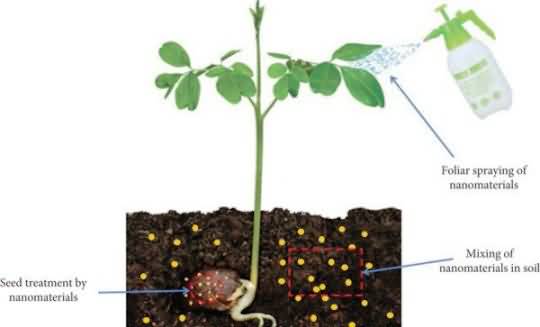 Source: Vijaykumar et al., 2022
Source: Vijaykumar et al., 2022
|
Nanoparticle |
Administration |
Plant species |
Abiotic stress |
Impact |
|
Zinc
|
Soybean seeds were placed in petri dishes with nano-zinc solution. |
Soyabean |
Drought |
improved seed residual weight reduction and germination rate. |
|
A foliar treatment to the leaf area |
Wheat |
Salinity |
Plant development improvement |
|
|
A suspension of nano-ZnO was applied to the pots. |
Wheat |
Mineral nutrition |
improved biomass and grain output |
|
|
The seeds were steeped in various Zn NPs suspensions. |
Rice |
Mineral nutrition |
Increased antioxidant activity and germination in plants |
|
|
Silica
|
Foliar application |
Tomato |
Salinity |
increased root length, chlorophyll content, photosynthetic rate, and leaf water content |
|
Soaking seeds in a solution of silicon nanoparticles |
Tomato |
Salinity |
accelerated the germination of seeds. increased pigments used in photosynthesis |
|
|
supplemented with nutritional solution |
Lentil |
Salinity |
increased germination and growth of seedlings. different defensive mechanisms improved |
|
|
|
Foliar application |
Wheat |
UV-B radiation |
increased protection of wheat seedlings by NO-mediated antioxidant defence and reduced UV-B radiation stress in seedlings so balancing the creation of harmful ROS |
|
Silver(Ag)
|
Seed priming |
Wheat |
Salinity |
reduced the detrimental effects of salinity stress. |
|
Foliar application |
Wheat |
Salinity |
a greater rate of seed germination. oxidative stress reduction. antioxidant enzymes induced |
|
|
In irrigation water |
Wheat |
Heat |
boosted growth and increased the amount of leaves |
|
|
added to the seedling's nutritional solution |
Soybean |
Flooding |
reduced the production of cytotoxic glycolysis byproducts and raised the amount of stress-related proteins and seedling growth. |
|
|
Mangnese
|
Foliar application |
Bell peppers |
Salinity |
enhanced root development and seed germination. Changing gene expression |
|
Selenium
|
In soil and Foliar application |
Wheat |
Drought and fungal infection |
maintained the amount of chlorophyll and carotenoid in the leaves, which facilitated plant growth and boosted biomass. |
Products of Nanobiotechnology
1. Nanourea
Additionally, with an annual consumption of 33.6 million tonnes in 2019–20, urea accounts for 82% of all nitrogenous fertilisers used in India. Conventional granular urea, which has a high nitrogen content of 46% and is offered at one of the lowest market costs, is one of the most significant nitrogenous fertilisers in the nation.
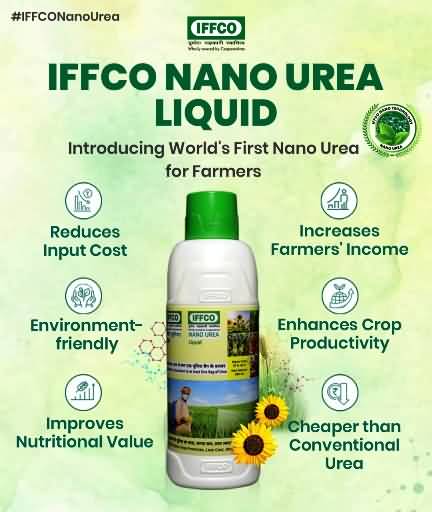
The Nano Biotechnology Research Centre (NBRC) of IFFCO in Kalol used proprietary technologies to develop Nanourea locally, invented and developed by IFFCO.
On August 1, 2021, Rashtriya Chemicals and Fertilizers and India Farmers Fertilizer Cooperative (IFFCO) began producing nano urea commercially (RCF). As a substitute for traditional urea, soil nutrients in liquid form give plants nitrogen. A 45 kg bag of regular urea is equal to a 500 ml bottle of nano urea.
With a 175 million investment, the first IFFCO nano urea (liquid) production unit was built in Kalol.
2. Nano Zinc
It is a nanotechnology micronutrient fertilizer. Nano Zn is adaptable because it can be applied to many types of crops. In fact, A viable substitute for zinc supplements for cattle is nano ZnO powder. A substitute for traditional zinc in animal feed supplements is nanozinc.
3. Krishna Agro Nano Biotech Capsule
It enhances soil qualities, raises the yield from 10% to 20%, and maintains soil fertility. Potash that has been mobilised is immediately available to the plants, which improves fertiliser utilisation and lowers the dose of chemical fertiliser.
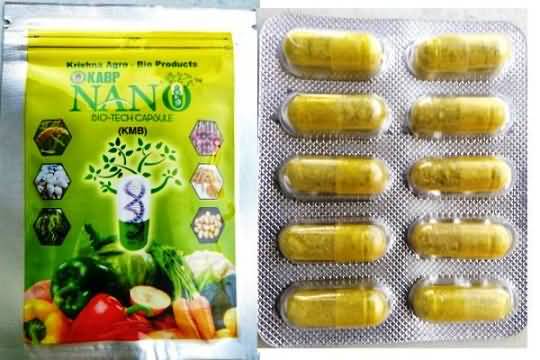
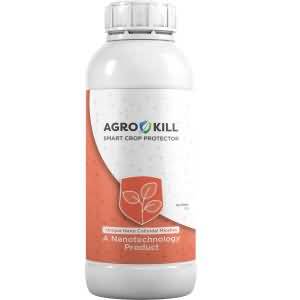 4. Agrokill Nanobee insecticide
4. Agrokill Nanobee insecticide
Crops are protected by Agro-Kill from a range of sucking pests as well as bacterial and fungal illnesses. In addition, it doesn't damage humans, plants, pollinators, natural enemies, predatory pests, or other animals. This is suitable for all significant crops.
It is a completely organic and non-cancerous product.
Conclusion
Nanobiotechnology has the ability to enhance plant stress resistance, stress sensing and detection, targeted pesticide delivery and controlled release, transgenic events, and seed nanopriming.
In order to increase production for smart agriculture, the technology can be utilised to "dress up" or treat seeds and roots. The plant is better equipped to grow and digest nutrients properly if we boost the metabolic activity of the seed or roots at the very beginning of their journey in the soil, just like we do with baby food.
In the future of agriculture, nanomaterials, in our opinion, will be extremely important
References:
- Priyanka, P., Kumar, D., Yadav, A., and Yadav, K. (2020). Nanobiotechnology and its application in agriculture and food production. In Nanotechnology for Food, Agriculture, and Environment.105-134.
- Zhao, L., Lu, L., Wang, A., Zhang, H., Huang, M., Wu, H. and Ji, R. (2020). Nano-biotechnology in agriculture: use of nanomaterials to promote plant growth and stress tolerance. Journal of agricultural and food chemistry.68(7):1935-1947.
- Vijayakumar, M. D., Surendhar, G. J., Natrayan, L., Patil, P. P., Ram, P. M., and Paramasivam, P. (2022). Evolution and recent scenario of nanotechnology in agriculture and food industries. Journal of Nanomaterials.1-33.
- War, J. M., Fazili, M. A., Mushtaq, W., Wani, A. H., and Bhat, M. Y. (2020). Role of nanotechnology in crop improvement. In Nanobiotechnology in Agriculture: 63-97.
- El-Saadony, M. T., Saad, A. M., Soliman, S. M., Salem, H. M., Desoky, E. S. M., Babalghith, A. O., and AbuQamar, S. F. (2022). Role of Nanoparticles in Enhancing Crop Tolerance to Abiotic Stress: A Comprehensive Review. Frontiers in Plant Science(13):1-
- Wang, L., Ning, C., Pan, T. and Cai, K. (2022). Role of Silica Nanoparticles in Abiotic and Biotic Stress Tolerance in Plants: A Review. International Journal of Molecular Sciences.23(4):1947.
Authors:
Swati Sharma, Sushma Pawar, Satish Kumar, Umesh Kamble, Amit Kumar Sharma CN Mishra* and Gyanendra Singh
ICAR-Indian Institute of Wheat and Barley Research Karnal-132001
